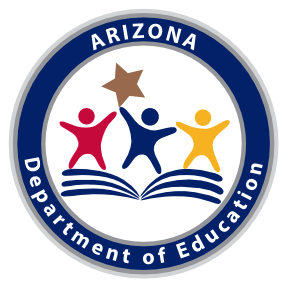Ed-Fi implementations usually involve standardizing SIS data and pulling it into a centralized Operational Data Store (ODS). Then, most districts and states look to standardize their assessment data next before working to develop dashboards or other visualization tools.
While this incremental approach often works well, it’s also important to be aware of the unique ways districts, states, and organizations are using Ed-Fi to get straight to the roots of their most pressing challenges. We want you to know what’s possible and dream big, then break it down into as many phases as you need to get there.
Here are some of our favorite examples of districts and states currently using Ed-Fi in unique and transformative ways.
Easing Transitions for Students in the Foster Care Program in Arizona
 Since announcing the launch of the Arizona Education Data Standards (AzEDS) in 2015, Arizona’s Department of Education has made a statewide commitment to becoming data-interoperable with Ed-Fi. They’re reaping many of the core benefits, including improved data quality, defined data governance, and more streamlined reporting. By committing to this approach AZ DoE has created a culture of data and is viewed among other state agencies as a leader in secure, real-time, data quality. Other agencies in the state are taking notice and asking DoE for assistance and data sharing to inform their own work.
Since announcing the launch of the Arizona Education Data Standards (AzEDS) in 2015, Arizona’s Department of Education has made a statewide commitment to becoming data-interoperable with Ed-Fi. They’re reaping many of the core benefits, including improved data quality, defined data governance, and more streamlined reporting. By committing to this approach AZ DoE has created a culture of data and is viewed among other state agencies as a leader in secure, real-time, data quality. Other agencies in the state are taking notice and asking DoE for assistance and data sharing to inform their own work.
The AZ Department of Child Safety (DCS), the agency that manages the state’s foster care program has been working with DoE to share data related to students’ locations, school feeder patterns and enrolled school. By securely sharing this data, DCS is able to better assist and support students in the foster care program by recommending home placements that enable students to remain at their currently enrolled school. This can be a game-changer for a student that is already experiencing a difficult time. Having continuity within the school environment can be a stabilizing factor and create security. Further, the DoE is making sure students’ records are promptly transferred when they move to new schools or districts within the state. This is especially impactful for the students in the foster care system—when their records travel with them, it softens the disruption to their educational paths and gives their new teachers an immediate understanding of their strengths and needs.This helps to create a welcoming environment for students where they already feel known and aren’t starting over when they do need to relocate.
Because AZ student records are standardized based on the Ed-Fi Data Standard, and AZ DoE is using an Ed-Fi based architecture; they have created an expectation of high-quality, reliable, secure and real-time data which has been put to use in highly beneficial and impactful ways not only in DoE but in other state agencies.
Ramping Up Mental Health Support & Suicide Prevention in Jennings County, Indiana
 Indiana University’s INSITE collaborative is working with numerous districts in their state to achieve data interoperability and get visualization tools into the hands of educators. Each of these districts has unique goals and needs.
Indiana University’s INSITE collaborative is working with numerous districts in their state to achieve data interoperability and get visualization tools into the hands of educators. Each of these districts has unique goals and needs.
Jennings County School Corporation, the most rural district INSITE partners with, is using their data to improve students’ social and emotional wellbeing. By collecting, standardizing, and centralizing information including crisis reports and child abuse referrals, as well as student survey results, Jennings has identified the most prevalent mental health challenges their students are grappling with—including addiction, depression, and suicidal ideation.
In response, the district has woven social and emotional learning into their strategic plan, and they’re taking action. Jennings County is capturing as much information about their students’ mental health as possible in order to detect warning signs and equip their teachers to provide support early and often.
Through a customized data dashboard, teachers in Jennings County now have actionable information at their fingertips, while still fully honoring students’ privacy and protecting their information. Where the data was previously buried in disparate systems and teachers were acting based on their direct interactions with students, they’re now able to keep tabs on warning signs like dropping grades, absences, and family challenges.
Preventing Student Dropouts in Delaware
 While Early Warning Systems (EWSs) are becoming more common, or at least a common goal of districts and states, Delaware has done a standup job of making their system both research-based and completely automated for educators. Based on the “ABCs” of student dropout risks—attendance, behavior, and course performance—the state is providing valuable information back to their educators every day.
While Early Warning Systems (EWSs) are becoming more common, or at least a common goal of districts and states, Delaware has done a standup job of making their system both research-based and completely automated for educators. Based on the “ABCs” of student dropout risks—attendance, behavior, and course performance—the state is providing valuable information back to their educators every day.
The Delaware DoE has rolled out their EWS plug-in supported by a lot of training, to make sure educators and district-level staff understand the indicators in the context of their own school cultures and students, ensuring they’re bought in and committed to taking full advantage of the system.
As described by the Delaware DoE, Delaware’s EWS “requires no new data collections or data entry activities to support implementation and use. Instead, the EWS plug-in uses data that are stored in the statewide SIS. Each day, the prior day’s data are extracted from the SIS, loaded into the state data warehouse, and then transformed and loaded into the EdInsight Dashboard… The EWS plug-in automatically flags students as at risk of dropping out of school if student data related to at least one at-risk indicator are found to be above a predefined threshold.”
What we love most is that Delaware didn’t start from scratch and reinvent the wheel; they based their system off of Pennsylvania’s previously conducted research and tools in the Ed-Fi Exchange.
Ensuring College & Career Readiness in Wisconsin
 Through the WISEdata initiative, Wisconsin’s Department of Public Instruction is leading the way with their state Ed-Fi implementation. One area where Wisconsin is ahead of the curve is college and career readiness; they’re enabling the use of predictive analytics to help students and teachers determine the best paths forward, including advising on whether or not students in grades 6, 7, 8, and 9 are likely to be ready for college and career.
Through the WISEdata initiative, Wisconsin’s Department of Public Instruction is leading the way with their state Ed-Fi implementation. One area where Wisconsin is ahead of the curve is college and career readiness; they’re enabling the use of predictive analytics to help students and teachers determine the best paths forward, including advising on whether or not students in grades 6, 7, 8, and 9 are likely to be ready for college and career.
To provide this information, the DPI applies machine learning technology to student data such as exam scores, mobility, and discipline in order to provide schools and districts with predictions of students’ future ACT scores and college enrollment.
Wisconsin DPI surfaces this information in their College and Career Readiness Early Warning System (CCREWS) for students in grades 6 through 9. The early identification of students who may not be on track provides schools and districts with the opportunity to provide additional support in time to make a real difference. This emphasis on college and career readiness aligns with the Wisconsin Department of Public Instruction’s mission: every child a graduate, college and career ready.
CCREWS is accompanied by a comprehensive system of support for academic and career planning. Through their data interoperability achievements on Ed-Fi, Wisconsin is building the capacity for district and school staff to make data-informed decisions with students.
Striving for Equity in San Francisco
 San Francisco Unified School District (SFUSD) has struggled to diversify its student population across their open-enrollment schools. Coupled with this lack of diversity, SFUSD has an undeniable equity gap. African American students are seeing disproportionate rates of chronic absenteeism, disciplinary action, and below-average student outcomes.
San Francisco Unified School District (SFUSD) has struggled to diversify its student population across their open-enrollment schools. Coupled with this lack of diversity, SFUSD has an undeniable equity gap. African American students are seeing disproportionate rates of chronic absenteeism, disciplinary action, and below-average student outcomes.
SFUSD’ graduation rate for African American students is 71% compared with a district average of 86.5%. And despite the fact that only 9% of SFUSD’s student population is African American, these students are accounting for over 40% of the district’s school suspensions.
Identifying, analyzing, and responding to this disproportionality is critically dependent on the district’s data systems, which up until now, have largely been limited to after-the-fact reporting. This year, SFUSD has embarked on an interoperability journey with Ed-Fi in order to produce impactful reports and interventions. These will include equity reports that source data from the Ed-Fi ODS to monitor and identify systemic equity issues from the Unified Data System; target student interventions based on absences, discipline, and performance that will surface in a new principal’s dashboard; tracking for vulnerable African American students in a new longitudinal data system.
The overall aim of SFUSD’s work with Ed-Fi is to provide educators and leaders with real-time data to help them close the district’s equity gap. This project will allow SFUSD to develop attendance, behavior, and assessment equity reports that will help educators identify and assist struggling students while helping district and school leaders adjust practices that are causing systemic inequity.
Increasing Parent Engagement at YES Prep
 YES Prep is an open-enrollment public charter school system in Houston’s underserved communities. More than 90% of YES Prep’s students are first-generation college students. Through multi-lingual support and plain language explanations of “education speak,” YES Prep empowers families to engage in their students’ learning experiences as many of them were never able to before.
YES Prep is an open-enrollment public charter school system in Houston’s underserved communities. More than 90% of YES Prep’s students are first-generation college students. Through multi-lingual support and plain language explanations of “education speak,” YES Prep empowers families to engage in their students’ learning experiences as many of them were never able to before.
Because YES Prep is a leader, they realized that when it comes to parent engagement, technology can significantly bolster and scale their efforts to help parents understand student performance and needs. So they’re currently developing a family portal off of the Ed-Fi ODS that will allow students and families to visualize student data in real-time, track graduation readiness through a mobile app, and automatically generate student-specific narrative and video reports (in multiple languages) that simplify students’ post-graduation options.
Through research with families, YES Prep discovered the need for another amazing feature that was not initially in scope. It’s a “communication module” for real-time communication between parents and teachers, with automatic translation between multiple languages. This addition was informed by a major pain point that surfaced during learning sessions: Even parents with English as a second language didn’t feel fully comfortable communicating with their students’ teachers in a detailed way.
When this new communication capability was demonstrated to parents, it received a spontaneous ovation! We’d like to join in that round of applause for YES Prep’s work to empower and engage parents for the betterment of their students.
You can check out more Ed-Fi use cases on our Ed-Fi in Action page! And to hear about creative uses of Ed-Fi like these directly from district and state leaders, don’t miss the upcoming Ed-Fi Summit. Registration closes on Monday, so don’t miss out!
